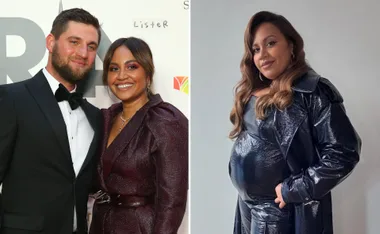This gorgeous quilt is the perfect finishing touch in a bedroom! This pattern is based on a variation of a 1944 design. Click here for pattern. This quilt consists of one block that is repeated many times. It can be assembled in hundreds of different ways. Our quilt was made into six blocks of 16 squares that were moved around to create the desired effect.
You can choose any colour combination for the quilt – the centre colours in ours were black and pink. It’s important to try to keep the colour values of medium to dark for A and B shapes and light to medium for the C triangles.
Measurements Finished size of quilt – 175cm (69”) x 135cm (53”) Size of inner patterned section – 122cm (48”) x 81cm (32”) Block size – 10cm (4”) Finished width of inner border (green) – 5cm (2”) Finished width of outer borders – 17.5cm (7”) Finished width of binding – 1.25cm (½”)
Materials For inner patterned section Colour 1 – 20cm each of 16 medium to dark or black fabrics Colour 2 – 10cm or scraps of each of 16 light to medium pinks For inner border 1.4m green fabric For the narrow inner border, outer borders and binding 1.8m fabric, in desired C colour Batting (approx 2.5cm – 4cm larger all around than the quilt top) Backing fabric (approx 2.5cm – 4cm larger all around than quilt top) Template plastic Steel ruler Pencil Craft knife White paper Black marking pen Water-soluble marking pen Quilting hoop Quilting needle Quilting thread
Templates Draw a sketch of your quilt first to get an overall picture of the colours. Make your templates using the supplied outlines. Trace the patterns onto the template plastic, marking the corners with dots and drawing lines between the dots using the ruler and the pencil. Cut out the templates using a craft knife, 6mm seam allowance all around. From each of the 16 (Colour 1) fabrics, cut 6 triangles (B) and 6 squares (A). From each of the 16 (Colour 2) fabrics, cut 12 triangles (C).
Piecing If hand piecing: With right sides facing, pin pieces together then work small running stitches along sewing line to join pieces, beginning and ending with a few back stitches at corners. If machine piecing: Set stitch length at 12-15 stitches per 2.5cm (1”). With right sides facing, place pieces together and feed under presser foot. (Patchwork and piecing feet are available at quilting and sewing stores and indicate perfect 6mm seams.) Join a short side of one triangles (C) to one side of square (A) then the other (C) to the adjacent side of (A) to form a triangle, the same size as the larger triangles (B). Join these two larger triangles together to form a square. You have now made a block. Mark another 95 blocks or as many as desired for the quilt size you wish to achieve.
Pressing Press seam allowance towards the darker fabric part of the block to prevent colours showing through. Press seams as you work.
Borders Measure the length of the quilt top through the centre. Cut side border strips to this measurement and join to quilt top. Measure the width of the quilt top through the centre. Cut border strips to this measurement and join to quilt top. If you are adding more than one border strip, measure the quilt after each addition to determine the measurements for the next border pieces.
Quilting patterns Mark your quilting pattern on the quilt top before layering the quilt. Trace our quilting patterns for the green inner border and the wide border, use your own design or purchase a commercial one.
Layering the quilt Make a sandwich of the quilt top, batting and backing. Spread the backing out on a flat surface and stretch it slightly pinning it to carpet or taping it to a hard surface. Centre the batting on top, then position the quilt top on top of these two layers. Starting from centre, baste or safety pin layers together or work large running stitches through layers.
Quilting Place the areas to be quilted in a hoop and stretch the fabric to create an even tension. Start hand quilting with small running stitches in the centre of the quilt and work out to the side. Sew through all three layers as you stitch. If machine stitching, use a walking foot on the machine and try to work quilting stitches in long continuous lines.
Finishing Cut binding pieces to fit the sides, top and bottom of your quilt, allowing extra fabric at the ends. (You will need to cut a number of binding strips and join them to create the correct length.) Fold and press the binding strips in half lengthways, then join the strips to the quilt top and bottom, then to the sides. When the strips have been stitched in place and trimmed to the correct size, fold under a narrow edge on the raw edge of the binding, fold the binding to the back of the quilt and slipstitch in place to secure firmly.
Quilt made by Gwen Mitchell; Story by Mary-Anne Danaher; Pics by Brett Stevens; Styling by Elizabeth Wagland.











